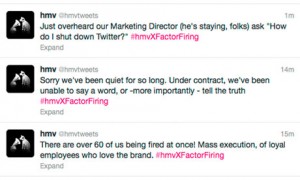 By now you’ve probably heard the story of the HMV employee gone rogue as a group of them were let go at once.
By now you’ve probably heard the story of the HMV employee gone rogue as a group of them were let go at once.
“We’re tweeting live from HR where we’re all being fired! Exciting!! #hmvXFactorFiring,” read the initial message from @HMVtweets, which has more than 70,000 Twitter followers.
This happened while 60 employees at the 91-year-old company were laid off during a round of downsizing.
Through seven subsequent tweets, Poppy Rose Cleere, the company’s newly axed 21-year-old online marketing and social media planner, aired the company’s dirty laundry to the world.
By the time the marketing director gained control of the account and deleted the offending messages, the damage had already been done…and the screen grabs had already been taken.
The tweets had gone viral and images were shared around the world.
The blogosphere first took notice (I saw it in several Facebook groups) and, by the next morning, every major news outlet was covering the story.
For the company, which just received bankruptcy protection, the PR debacle had extremely bad timing.
Making Hard Decisions
As a business owner who has had to do a round of layoffs, this is extremely painful. Sometimes you have to make decisions that are best for the health of the company and, unfortunately, that means letting people go.
I don’t consider layoffs as people being fired, but I know it doesn’t feel any differently to those on the other side of the desk.
I also don’t think it’s the wisest idea to tell everyone at once, though I understand when it’s a group as large as HMV let go, you have to do it as quickly and painlessly as possible or everyone starts to talk and speculate and create rumors.
I wasn’t going to write about this debacle until I read a blog post yesterday Yvette Pistorio wrote for a client…and she freaked me out!
Wake-Up Call
In it, she talked about how company social media accounts should have one universal password that is as easy to shut down as a person’s email account if they leave.
Um…
As it turns out, my team keeps social media passwords in a centrally located, and locked down, file we can all access. But I’ll admit I had to look in there yesterday to be sure.
But there are two other things you should consider for the organization’s social media accounts:
- Centralize all the networks. We use Hootsuite for Facebook, Twitter, LinkedIn, and Google+. With the exception of Facebook, I am one of the admins on the other accounts. On Facebook, there are three people as admins so, if one person leaves, the other two can lock it down.
- Control access through limited permissions. If you insist on giving junior employees the keys to your social networks, do so with caution. There are tools now (Hootsuite included) that allow you to assign permissions so junior-level employees can draft messages, but someone more senior has to approve them before they can be published. This kind of access probably would have saved Applebee’s from their PR crisis last week.
Yvette and I joked about this yesterday and she assured me she’d never go rogue. I don’t believe she would, but as an organization gets bigger, it’s impossible to understand the motivations of every, single person who works with you.
These kinds of things not only keep you safe from rogue employees, but they’re smart.
How do you manage social media so the company isn’t vulnerable to an angry employee?